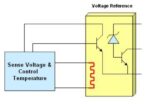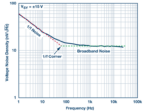Modern zero-drift amplifiers provide the extremely low drift and noise performance needed for processing many optical biological, and physical-world signals near 0 Hz. In our world of ever-faster, wider-bandwidth signals and systems operating at higher and higher frequencies, it may seem that signals in the very-low-frequency range — down towards zero hertz (0 Hz) — […]
Featured
When to buffer and when to drive signals
Buffers and drivers both provide impedance transformation between the input and output. The differences begin to appear when looking at the common types of buffers and drivers, for example, voltage and current buffers, clock buffers, line drivers, and gate drivers. Basic buffers and drivers have one input and one output, but there are others that […]
How to specify and use analog switches
An analog switch is an IC that can be used to control connections to analog and digital signals. These switches provide bidirectional connections when “on” and high impedance paths when “off.” There’s a wide range of analog switches for special functions. In some instances, they are used in place of mechanical switches. In other embodiments, […]
How do comparators and op amps compare?
Operational amplifiers (op amps) and comparators have two inputs, inverting and noninverting, and an output that can usually swing from rail to rail and have the same schematic symbol. So, what’s the difference? This FAQ compares the two devices and digs into some of the similarities and differences. It begins with a top-level comparison of […]
How to specify and use voltage references
Voltage references are small components that can have a significant impact, either positive or negative, on system performance. They are precision devices that maintain a constant voltage output even in the presence of changes in temperature, input voltage, and other external parameters. When measuring the analog world, voltage references ensure that data converters, detection circuits, […]
What’s the difference between transceivers and transponders?
Transceivers and transponders are types of communication devices. They can operate with RF or optical technologies. They are used in various environments, from terrestrial to undersea and outer space. Basic transceivers and transponders provide two-way links in various types of networks. Specialized devices like muxponders increase available bandwidth, extend network reach and improve network efficiency. […]
PCB design best practices for ECAD/MCAD collaboration
By Alex Grange, Siemens EDA As designs grow in scope and complexity, collaboration between the electronic and mechanical domains is even more important. For example, as PCB designs face tighter requirements, problems resulting from electromechanical interference are becoming more common. Handling these problems across disciplines requires constant collaboration and synchronized data. What isn’t working today […]
Open RAN networks pass the time
Network elements must meet certain frequency, phase, and time requirements to ensure proper end-to-end network operation. Synchronization architectures defined by the O-RAN alliance dictate how Open RAN equipment can meet these requirements. Open RAN continues to attract interest from service providers looking to reduce cost, improve competition, and drive technology innovation. The desire for a…
Minimizing electrical noise to improve medical-ultrasound images, Part 3
Low-noise circuitry is critical to image quality of medical ultrasound, an indispensable diagnostic tool. Efficiency versus noise It may seem that if there is a tradeoff between power-supply noise versus potential efficiency, the need for ultralow noise in the ultrasound application should prevail. After all, a few more tens of milliwatts of dissipation should not […]
Why should you be using rigid-flex PCBs rather than flex PCBs in your next project?
by Ken Ghadia, Sales Engineer, TechnoTronix Rigid-flex or rigid-flexible PCBs are the preferred interconnection circuits in today’s electronics. They have simplified the PCB assembly with superior mechanical stability and electrical reliability features. The driving factors for their popularity are reduced product weight, compact packaging, and quick assembly. Rigid-flex PCBs were designed primarily for critical interconnections in […]










